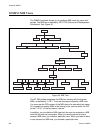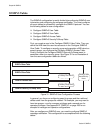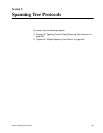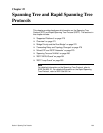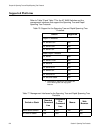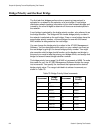AT-S63 Management Software Features Guide
Section IV: SNMPv3 265
SNMPv3 Notify
Table
The Configure SNMPv3 Notify Table menu allows you to define the type of
message that is sent from the switch to the SNMP host. In addition, you
have the option of defining the message type as either an Inform or a Trap
message. The difference between these two types of messages is that
when a switch sends an Inform message, the switch expects a response
from the host. In comparison, the switch does not expect the host to
respond to Trap messages.
In addition, you define a Notify Tag that links an SNMPv3 Notify Table
entry to the host IP address defined in the Configure SNMPv3 Target
Address Table menu. Lastly, you can configure a storage type for this
table entry which allows you to save the entry to flash memory.
SNMPv3 Target
Address Table
The Configure SNMPv3 Target Address Table menu allows you to
configure the IP address of the host. Also, in an SNMPv3 Target Address
Table entry, you configure the values of the Tag List parameter with the
previously defined Notify Tag parameter values. The Notify Tag parameter
is configured in the Configure SNMPv3 Notify Table. In this way, the Notify
and Target Address tables are linked. Lastly, you can configure a storage
type for this table entry which allows you to save the entry to flash
memory.
SNMPv3 Target
Parameters Table
The Configure SNMPv3 Target Parameters Table menu allows you to
define which user can send messages to the host IP address defined in
the Configure SNMPv3 Target Address Table. The user and its associated
information is previously configured in the Configure SNMPv3 User Table,
SNMPv3 View Table, SNMPv3 Access Table, and SNMPv3
SecurityToGroup Table. Lastly, you can configure a storage type for this
table entry which allows you to save the entry to flash memory.
SNMPv3
Community
Table
The Configure SNMPv3 Community Table menu allows you to configure
SNMPv1 and SNMPv2c communities. If you are going to use the SNMPv3
Tables to configure SNMPv1 and SNMPv2c communities, start with the
SNMPv3 Community Table.




